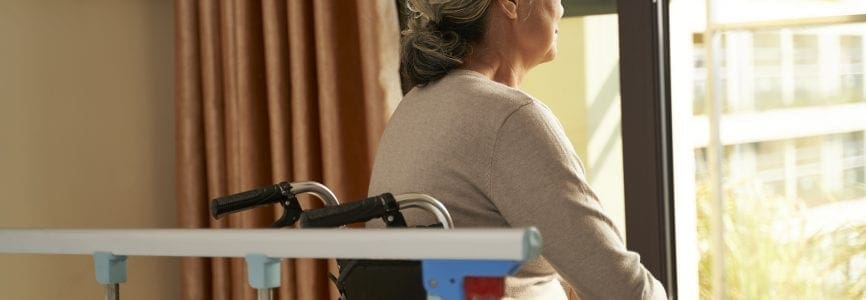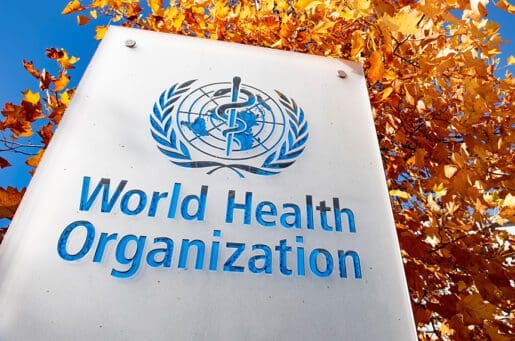Bioethics Forum Essay
Vaccinated and Still Isolated: The Ethics of Overprotecting Nursing Home Residents
The pandemic is not over, but light is beginning to crest the horizon. Vaccination rates, especially among older adults and their caregivers, are rising. As we begin to relax physical distancing requirements on restaurants and professional sports, it’s time to urgently reconsider the severe restrictions imposed on nursing home residents.
Before the pandemic, nursing homes offered not only health care, but also a social life — meals with friends, art classes, musical performances, holiday and birthday celebrations, religious services, and the opportunity to receive visitors. Suspension of these positive aspects of congregate living with the aim of protecting residents from infection has had dramatic, harmful secondary effects: lethargy, loss of appetite, physical deconditioning, cognitive decline, hopelessness, anxiety, depression, and social isolation. While these adverse effects are more difficult to quantify than Covid-19 infection rates and mortality, they must not be ignored.
Nursing homes have been epicenters of the pandemic. They present a constellation of factors that have created a perfect environment for Covid-19 to spread rapidly and take lives. Individuals who live in nursing homes are at high risk for serious illness and death from Covid-19, due to advanced age, dementia, and/or comorbid conditions. In the early months of the pandemic, nursing homes were recognized as serving a particularly vulnerable population. However, they were not prioritized for allocations of personal protective equipment or Covid-19 tests when both were in short supply. Infection-control measures focused on minimizing exposure risk by severely restricting residents’ contact with others. Visitation by family and friends, communal dining, group activities, and socializing with other residents in common areas were restricted or forbidden outright.
Today, PPE and Covid tests are readily available, and nursing home residents and staff have been a top priority for the Covid vaccines. More than 75% of U.S. nursing home residents and more than 50% of staff are fully vaccinated . However, the mandatory social isolation of residents remains largely in place. While federal and state authorities have begun to lift restrictions cautiously and slowly, the urgency of the situation requires swifter action.
Many nursing home residents are suffering as a result of the loss of human contact with family and one another. As social beings, connecting to others is crucial to our mental health and well-being. While social restrictions may have been justified in the early months of the pandemic, it is no longer clear that the benefit of continued restrictions outweighs the harm.
It is practically feasible and ethically sound to reinstitute activities that promote socialization on a more routine basis. While restrictions are loosening, there is urgency to moving forward at a brisker pace. People living in nursing homes are not being permitted the same level of freedom and choice as their fellow Americans. Due to spread in the community, it is commonplace for nursing homes to identify asymptomatic cases through routine testing of staff. With each positive test the nursing homes must suspend visitation for a period of time and place affected units in isolation for at least 14 days. In New York, where routine testing is conducted twice weekly, these cases arise frequently. In an excess of caution, health authorities sometimes require the facility to confine not only residents of affected units, but all residents to their rooms every time a positive case is identified.
Consider an 85-year-old nursing home resident with dementia who is fully vaccinated and asymptomatic, but is required to isolate in her room after an asymptomatic staff member tests positive. With current restrictions in place, even having been vaccinated against Covid, she is not allowed to visit a neighbor or participate in a music program with other nursing homes residents. The social isolation and the disruption of her routine is traumatic, causing increased anxiety, despair, and worsening confusion. She stops eating and drinking, facing a risk of dehydration and serious illness. These are preventable harms caused not by Covid-19, but by the regulatory response to it.
If this same woman were able to live at home, she would have few limitations after vaccination. She would be able to visit with a neighbor, perhaps go to the lobby of her building and enjoy music or conversation, and indeed see, touch, and hug her vaccinated family members. For fully-vaccinated people living in the community, the Centers for Disease Control and Prevention offers guidance for safe visitation and socialization with others. This is in stark contrast to Centers for Medicare and Medicaid Services guidance for fully-vaccinated people living in nursing homes The significant disparity in guidance for these two populations is problematic and unjust.
Balancing the demands of infection control and the need for social engagement is tricky in nursing homes, just as it is in society as a whole. The congregate living environment of a nursing home and the close personal contact with caregivers may justify some infection prevention measures that are not needed in the community. Infection control measures that restrict the liberty of residents, however, require robust ethical justification. As conditions and evidence evolve, so too must the process of ethical analysis and the calculations of harm and benefit. Policies intended to reduce the risk of harm must not cause secondary harms that, cumulatively, are disproportionate to the realized benefits of risk reduction. We submit that continuing severe restriction of visitation and social activity, including quarantine requirements for fully-vaccinated nursing home residents, is causing more harm than good. There is a middle ground between the strict isolation we see today and high-risk social contact. An ethical approach to visitation and congregate activities for people in nursing homes requires navigating that middle ground.
The focus of regulators and media has been on deaths in nursing homes. We suggest that regulators, the media, and our bioethics colleagues also focus on life in nursing homes. The continued isolation of residents is a public health emergency that policy-makers should address with passion and vigor. Prioritizing nursing home residents for vaccinations reflects the high value we as a society place on protecting life. Most nursing home residents have an anticipated limited lifespan. Let us promote a high quality of life for those that live in nursing homes by opening the doors to visitors and resuming socialization in a comprehensive and thoughtful manner. We all know that no virtual visit can replace a warm hug.
Members of the Long-Term Care Workgroup are Nancy Berlinger, PhD (berlingern@thehastingscenter.org); Jennifer B. Breznay, MD, MPH (jbreznay@maimonidesmed.org); Nancy Neveloff Dubler, LLB (nancy.dubler@nychhc.org); Howard Finger, DO (howard.finger@nychhc.org); Timothy W. Kirk, PhD, HEC-C (tkirk@york.cuny.edu); Karen Lipson, JD (klipson@leadingageny.org); Debjani Mukherjee, PhD, HEC-C (dem9199@med.cornell.edu); and Elizabeth G. Weingast, RN, MSN, GNP (eweingast@jewishhome.org). Views represented are those of the authors as a workgroup. They do not represent views of the authors’ employers.













This is so obvious it’s hard to understand the reason for the Medicare guidelines. I’m guessing this is not a scientific or an ethical issue, but a cya bureaucratic response based on fear of lawsuits. Glad to see the issue exposed.
On behalf of the authors, thank you for your comment. As we suggest in our reply to Joanne Lynn’s comment, the “bureaucratic response” is an issue of organizational ethics if not bioethics. Given that health and social care systems rely on bureaucracies, political philosopher Sophie Bourgeault has called for “more caring and just bureaucracies.”
I appreciate the essay and its thrust, but I’d call on your team to address the human rights issue as well as the issues of physical well-being. Not only were the nursing home residents put into solitary confinement “for their safety,” but neither they nor their families (or other representatives) were asked how they would balance the merits (and no governmental guidance called on anyone to consider these preferences). In short, they were treated as cattle, for whom only “safety” mattered. The affront to human dignity is palpable. The society could not have done this to any other group, except prisoners. I certainly understand that preferences to be free of some or all constraints could not always (and, early on, perhaps could not ever) be accommodated – but the residents and their families at least deserved to be heard, to be accommodated when possible, and to receive apologies if public health considerations barred operationalizing their preferences. Indeed, I believe “we” owe nursing home residents reparations for false imprisonment (which might take the form of actually undertaking the reforms needed to make congregate living in old age much more comforting , meaningful, and safe).
On behalf of the authors, thank you for your careful reading of this essay and your thoughtful comments, reflecting your expert knowledge of the problems we describe. Our analysis of a problem of overprotection and inequity within a vulnerable population – namely, the stark difference in how fully vaccinated older adults can use the social benefits of vaccination sits at the intersection of bioethics, social gerontology, and organizational ethics. Certainly, this problem could also be framed in terms of human rights and freedoms. In view of the extensive public health and media attention to the social benefits of vaccination for older adults – hugging grandchildren, gathering safely with fully vaccinated friends – we chose to focus on the problem of forgetting that older adults in congregate living need and should enjoy these same benefits. Pragmatically, we aim to point policymakers, nursing home administrators, and others toward a corrective pathway that balances safety with social wellbeing. Let’s hope this can be the first step toward “undertaking the reforms needed to make congregate living in old age much more comforting, meaningful, and safe.”
CDC guidelines since Day 1 have harmed the elderly especially those in nursing home facilities. The data by June, 2020 showed who was dying from Covid. Did our public officials in many states where this problem was fierce do anything – MA, NY, NJ, etc.; No. We could have protected people using our vast resources and we didn’t. Now the same public officials continue to wreak havoc on the elderly with illogical-baseless rules. I hope your views get heard by these officials and things change very soon.
On behalf of the authors, thank you for your comment.
After reading this brilliant piece, I came up with the following acronym. A simple reminder to the Resident’s Bill of Rights
Restrict my rights only when there is proven risks
Enable me to make choices, whenever possible
Socialization should be maximized, as long as viral transmission can be minimized
Protecting my life at all costs may be a price too high for me
Ethics demand that all my needs are addressed. My emotional and social needs and no less important than my medical and physical needs
Community activities/involvement are essential to my wellbeing
Treat me no differently than someone not living in a congregant living situation
My tolerance to behaviors that could transmit infections should be determined and followed
Enlist all forces (political and industry) to minimize rules that do not allow me to live my life as I chose
On behalf of the authors, thank you for your comment. You may be interested in this further discussion of these issues, drawing on our piece: https://theweek.com/articles/978412/reopen-nursing-homes
Thank you – this is the ONLY article that I have seen on this critical issue. Hits close to home since the Washington DC Health Dept continues to essentially hold my Mom hostage in her assisted living home and yet in Florida, family members are able to visit in their rooms and take their loved ones off campus for visits. My Mom received her second vaccine on Feb 6 and is still being held against her will and this is likely not constistutional as there is no health threat to a building with double vaccinated seniors of some senior going and visiting off-campus with family (if a senior dare to leave they are forced into a 14 DAY QUARANTINE). Easy to remove rights and in some areas (not Florida) it’s hard for some officials to remember to give those rights back to people……
On behalf of the authors, thank you for your comment. We were encouraged to see that this blog post is cited in a new editorial in The Week, suggesting growing public awareness of the problems you describe, including state-level differences: https://theweek.com/articles/978412/reopen-nursing-homes
Wonderfully written. As the medical director of a CCRC in New Jersey I could not agree more. Similarly, we have had to impose these lockdowns. 100% of our assisted living residents received a second vaccine over 2 months ago. We also have had a handful of our residents test positive since then, completely asymptomatic, but the state requires us to quarantine them for 2 weeks. Also delaying the communal activities for the entire building for another month. Now that they are all protected, every single resident, and every single family member would gladly resume activities, communal dining, and safe visitation accepting the minimal if not zero risk of severe illness from infection. We have lost 10 times as many residents during the pandemic from weight loss, failure to thrive, depression than we have from COVID. Not to mention the mental decline in our residents with dementia, the depression, the delusions and hallucinations that have increased. For the first time in my 30 year career as a geriatrician I feel as I am doing more harm than good to my residents. This is truly one of the most frustrating things I have had to go through in my entire career. Thank you for shedding some light on the “hidden pandemic”.
On behalf of the authors, thank you for comment and for your perspectives from practice on the health and wellbeing consequences of overprotection and on the moral distress of professionals confronted with a situation they cannot resolve on their own.
Excellent argument. I am in my Doctorate if Nutsing Oractice program and this was my focused problem, however the long-term home in my town refused to have me do my study on decreasing loneliness. I am now focusing on home bound older adults in the community with the same outline and intervention of weekly calls.
On behalf of the authors, thank you for your comment, and best wishes in your research.